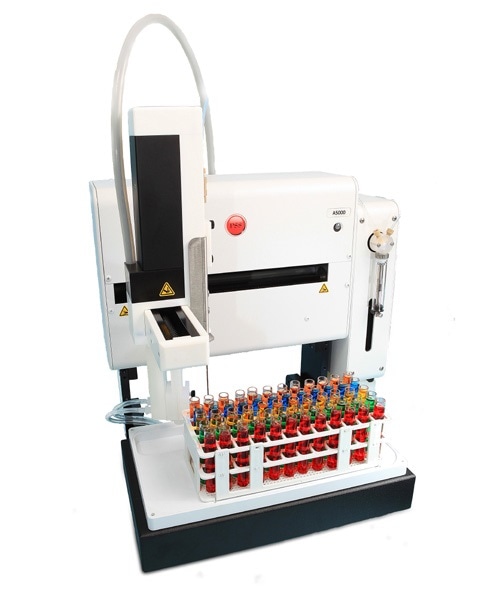In order to quantify the count and size of subvisible particles in eye care products, the USP <789> test is carried out. This consists of utilizing a light obscuration particle counter and counting particles on a filter by microscopy.
This article outlines the tests needed and demonstrates how the Entegris AccuSizer® A7000 SIS system is designed to meet, and exceed, all requirements. There are two approaches to detecting subvisible particles which are present in these solutions.
Stage 1 uses light obscuration (the AccuSizer) to size and count the particles. The sample must pass the microscopic procedure (Stage 2), which has its own set of limits, if the stage 1 test fails. Sampling plans must be based on factors like count variability between units, product volume, size distribution of the particles present, and historic count data.
The system requirements for a light obscuration instrument which is utilized to comply with USP <789> are similar to USP <788> and include:
Sensor: The concentration range should be more than the concentration of the particles to be counted. The smallest size particle to be measured must be included in the dynamic range. The sensor must be calibrated for size at a number of points, tested for resolution, and checked for count efficiency.
Technique: Light obscuration sensor with sample feeding device that is suitable.
Sampler: The sample volume accuracy must be within 5 % of the appropriate sample volume for the test.
Reporting: Particle concentration ≥10 and 25 μm.
The AccuSizer A7000 SIS syringe injection sampler, manufactured by particle sizing systems, is designed specifically for customers carrying out USP <789> and <788> particle testing.
.jpg)
Image Credit: Entegris Particle Sizing
The LE400 is the standard sensor which is utilized for USP <788> testing. It measures from 0.5 – 400 μm at concentrations up to 9000 particles/mL. It is a high resolution particle sizing sensor with a patented optical design.
Unlike classical contamination monitoring systems, which have 6 or 8 size classification channels, the sensor is paired with the AccuSizer high resolution counter, which contains over 512 size channels. Each sensor is calibrated with ten particle size standards over the complete range and is validated for count efficiency at 15 μm.
.jpg)
Image Credit: Entegris Particle Sizing
Usually 5%, the resolution is much better than the 10% needed in USP <788>. The AccuSizer A7000 SIS sampler can deliver very accurate volumetric sample aliquots for applications ranging from USP <789> testing to protein aggregation studies at much lower sample volume (~150 μL).
Interpretation
If the average number of particles present in the units tested does not exceed the appropriate values listed in Table 1 then the ophthalmic solution passes the USP <789> test.
Table 1. Count limits for USP <789>. Source: Entegris Particle Sizing
| . |
. |
. |
| Diameter |
≥10 µm |
≥25 µm |
| Number of particles |
50/mL |
5/mL |
Experimental
Two ophthalmic “red eye” solutions were bought at a local pharmacy in Port Richey, FL, USA, with both bottles containing 30 mL of solution. One will be referred to as “Generic” and the other “Brand.” In order to make three measurements of 5 mL for each sample, a test protocol was programmed into the A7000.
The first analysis was not utilized, and the second and third were reported at ≥10 and ≥25 μm. Figures 1 and 2 show the results from the Brand and Generic sample analyses, which all pass the USP <789> limits easily.
.jpg)
Figure 1. Brand red eye results. Image Credit: Entegris Particle Sizing
.jpg)
Figure 2. Generic red eye results. Image Credit: Entegris Particle Sizing
The Brand sample was then spiked with 20 μL of a PSL standard from Micro Measurement Labs that had been previously utilized to check the calibration of the sensor at 10, 25 and 50 μm. This result, which can be seen in Figure 3, fails the USP <789> limits.
.jpg)
Figure 3. Brand spiked with PSL standard. Image Credit: Entegris Particle Sizing
Conclusions
The AccuSizer A7000 SIS Syringe Injection Sampler exceeds all requirements defined in USP <789> for ophthalmic solutions. The AccuSizer software platform is the most advanced package for carrying out these tests and will continue to support future requirements.

Figure 4. Autosampler integrated with the AccuSizer A7000 SIS sampler. Image Credit: Entegris Particle Sizing
In addition, for automated batch sampling of up to 60 samples/tray, this system can be integrated with the Autosampler seen in Figure 4. Dual trays are also available.
About Entegris Particle Sizing
Since our inception in 1978 we have been providing leading edge instrumentation for the field of particle size analysis. We are an applications driven company that provides solutions to our customer's most complex particle sizing and zeta potential monitoring problems. From wet to dry, online to research laboratory we have engineered a complete family of modular designed instruments that can be configured to meet the specific demands of an application.
Single particle optical sizing (SPOS)
The Entegris AccuSizer operates using the principle of single particle optical sizing (SPOS). This technique generates high accuracy, high resolution particle size distribution results as well as concentration data in particles/mL. The AccuSizer platform includes multiple configurations designed to meet a wide array of applications including laboratory and online systems. Multiple sensor options cover a wide range of particle size and concentration limits. Advanced fluidics modules can handle low concentration samples requiring no dilution to highly concentrated inks and CMP slurries using our patented two stage exponential dilution system.
Dynamic light scattering
The Nicomp dynamic light scattering (DLS) system measures particle size below 1 nm and zeta potential to study particle charge. The unique Nicomp algorithm provides the highest resolution results for samples containing more than one peak. Other unique capabilities include auto-dilution and auto-samplers to facilitate high sample throughput.
Sponsored Content Policy: News-Medical.net publishes articles and related content that may be derived from sources where we have existing commercial relationships, provided such content adds value to the core editorial ethos of News-Medical.Net which is to educate and inform site visitors interested in medical research, science, medical devices and treatments.